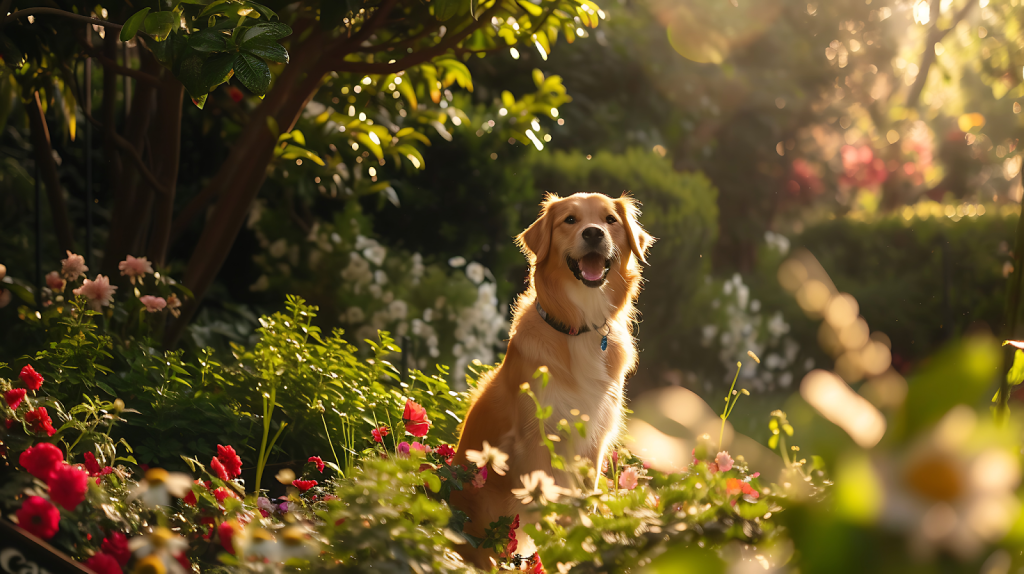- Expert tips on how to blend beauty and safety in your outdoor space
- Clever hack shows how you can revive your patchy lawn with a popular bath item
The garden is a great place for pets and owners to relax and exercise – however, research shows around 7.8 million dogs in the UK could be exposed to poisonous garden plants, highlighting the need for pet-safe outdoor spaces.
As gardening enthusiasts increasingly share their outdoor havens with furry companions, the challenge is creating a space that’s both aesthetically pleasing and safe for pets.
To address this growing need, pet sitting platform TrustedHousesitters has partnered with Nathan Thorne, a gardening and landscaping expert at Handy Flowers, to offer innovative solutions for pet owners looking to revamp their outdoor areas.
“Aesthetic and pet-friendly gardens do not come by default. You have to plan what will not only look great but will also be safe for your pets,” says Thorne. Here are his top tips for creating a harmonious outdoor space:
- Be smart with landscaping
Thorne emphasises the importance of thoughtful design: “Use pet-safe materials on walkways and edges such as gravel and smooth stones. This will prevent pets from stepping on sensitive plants and provide clear areas for them to walk and play.”
For plant enthusiasts worried about curious pets, Thorne suggests vertical gardening: “Incorporate growing elements such as trellises, arbours, or hanging planters. This enhances the garden’s aesthetics while keeping plants off the ground, reducing pet accessibility and allowing more play space.”
2. Create pet-friendly zones
Designating specific areas for pets can help maintain the garden’s overall health. Thorne recommends, “Give a patch of your garden to pet-friendly grass or artificial turf. This gives pets a particular area for playing, rolling, and even toileting without destroying the rest of your garden.”
If your pet’s favourite spot starts to look worn or patchy, you can easily repair the small patches of lawn using a budget-friendly hack with Epsom salt. Simply dissolve two tablespoons of Epsom salt per gallon of water and use it to water the patchy area. This inexpensive solution will help promote healthier grass without the need for chemical fertilisers.
3. Choose elevated gardening for a win-win solution
Raised beds are a game-changer for pet owners who love to grow vegetables and flowers. “Use raised beds to plant flowers and vegetables,” Thorne advises. “It’s a way to keep garden plants away from curious pets and prevent them from trampling or digging up more delicate plants.”
4. Look for safe and stimulating plant choices
Selecting the right plants is crucial. “Choose plants that are non-toxic to pets,” says Thorne. “Some examples include marigolds, petunias, sunflowers, and herbs like basil and parsley. Avoid plants that are toxic to pets, such as lilies, azaleas, and certain types of ferns.”
For an extra pet-friendly touch, Thorne suggests, “Make a herb garden containing catnip for cats, mint, and cat thyme in pots or on windowsills. They will add fragrance and beauty to your garden, acting like safe treats for your pets.”
5. Create a safe haven with pet comfort features
Ensuring your pet’s comfort is key to a successful garden. Thorne advises, “Create shaded and sheltered spots where pets can escape and rest easily, especially in hot weather conditions. Consider introducing a pet-friendly canopy or a small outdoor shelter to shield them from the sun and rain.”
He also stresses the importance of hydration: “Keep fresh, clean water easily accessible in multiple locations throughout the garden. Consider installing a pet-friendly fountain or shallow water feature where pets can drink safely.”
6. Work in interactive elements
To keep pets engaged and exercised, Thorne recommends adding some fun features: “Include pet-friendly toys and agility equipment like tunnels, ramps, or a selection of small obstacle games to play with the dogs and exercise.”
7. Keep pets in mind for maintenance
Regular garden maintenance should always consider pet safety. Thorne advises, “Continue with routine and regular checks of the garden for any toxic plants, chemicals, or hazards to animals. Ensure all garden products and treatments are pet safe.”
By implementing these expert tips, UK garden enthusiasts can create outdoor spaces that are both visually stunning and safe for their beloved pets. “With these strategies,” Thorne concludes, “pet lovers can design a garden that enhances the aesthetic of their outdoor area and makes the environment safe and fun for pets to explore.”
For more information on poisonous plants to avoid around dogs, visit the TrustedHousesitters blog.



